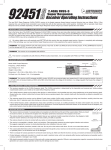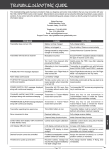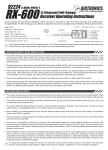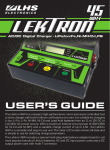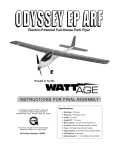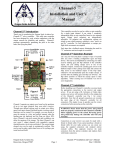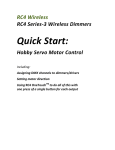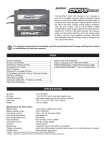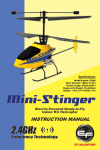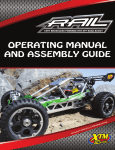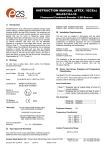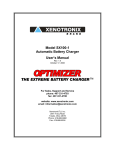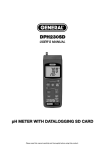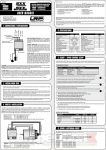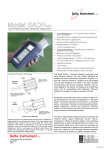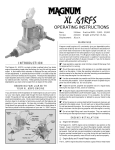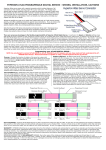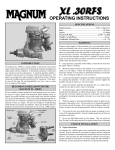Download TR sensored Brushless competition esc user`s Guide
Transcript
#96338 Sensored Brushless Competition ESC User’s Guide features and specifications • Brushless Sensored Design w/Custom Sanwa Programming • Motor Limit: 3.5T w/1S LiPo or 4.5T w/2S LiPo • Adjustable Voltage Cutoff • On Resistance: 0.00038 ohms • Twelve Programming Modes (Red, Blue & Green Setup LEDs) • Rated Current : 740 Amps/Phase @ 25ºC (77ºF) • Thermal Overload Protection Circuit • BEC: 6.0V/3.0A • Compatible with Normal, SHR and SSR Channel Modes* • Dimensions: 1.25 x 1.39 x 0.77” (32.0 x 35.5 x 19.7mm) • Supports Remote Programming via Transmitter* • Weight: 42g (Excluding Wiring and Power Capacitor) • Input Power (Cells): 1S or 2S LiPo (4C to 6C Ni-Cd/Ni-MH) *When used with compatible Airtronics or Sanwa transmitter and receiver. what’s included • Super Vortex Zero Competition ESC • 3 Feet 12AWG Flexible Silicone Wire • Sensor Cable • Heat-Shrink Tubing • Cooling Fan w/Mounting Screws • User’s Guide precautions and warnings • This ESC is designed for use with Airtronics or Sanwa 2.4GHz radio systems. Functionality of this ESC with radio system brands other than Airtronics or Sanwa may differ. Carefully check the function of the radio system when a brand other than Airtronics or Sanwa is used. • This ESC is designed for use with 3.5T or greater (w/1S LiPo) and 4.5T or greater (w/2S LiPo) sensored brushless motors only. • When soldering the motor and battery wires to the ESC, be careful not to overheat the mounting posts or damage can result. • When soldering your battery connector and battery wires to the ESC, please observe correct polarity. Plugging the battery into the ESC with reverse polarity will damage the ESC beyond repair! Use high-quality 4mm bullet connectors, Dean’s Ultra-Plug or similar. • The power capacitor installed on the ESC is mandatory for proper use. Do not remove the power capacitor. • Do not use a battery with a nominal input voltage greater than 7.4 volts (2S LiPo or 6C Ni-Cd/Ni-MH). • If the ESC and/or your battery become hot, disconnect your battery from the ESC immediately and allow the ESC and/or your battery to cool down before reconnecting. • Mount the ESC using double-sided foam tape and in a position that allows for adequate airflow. If airflow is limited, install the included cooling fan onto the ESC if room permits under your vehicle’s body. • Turn your transmitter ON before turning the ESC ON and turn the ESC OFF before turning your transmitter OFF. • Always disconnect your battery from the ESC when not in use. • The ESC is not waterproof. Do not run through water or allow the ESC to become wet with moisture or the ESC can be damaged. • Maintain your motor on a regular basis to ensure high performance. Degradation of motor performance can put undue stress on the ESC, resulting in damage to the ESC. overview, connections and mounting To Battery To Motor B To To Motor A Motor C Setup Button On/Off Switch Fan Input Sensor Input To Battery Throttle Lead (to RX CH 2)* *Blue (Signal)/Red (Positive)/Black (Negative) Soldering Battery Wires and Motor Wires: To Battery Capacitor** Setup LEDs **Secure the capacitor to the battery wires or the chassis using a nylon cable tie (not included) to prevent it from being damaged or from shaking loose during use. IMPORTANT: When soldering your battery connector and battery wires to the ESC, please observe correct polarity - positive to positive and negative to negative. When soldering the motor wires to the ESC and your motor, make sure that the wiring matches - A, B and C from the ESC to A, B and C on your motor. Refer to the diagrams above. 1) Cut the silicone wire included into three lengths long enough to connect between the ESC and your motor, then two equal lengths long enough to connect between the ESC and your battery. Strip approximately 3/32” to 1/8” of insulation off the ends of the wires to prepare them for soldering. For optimum performance, the motor wires (A, B and C) should all be equal length. 2) Using a rosin-core solder and a sufficiently hot soldering iron, pre-tin the ends of each wire. To do this, heat the end of the wire and apply solder until it is thoroughly covered. Next, pre-tin the battery mounting posts and motor mounting posts on the ESC by heating each mounting post and applying enough solder to cover the mounting post with a thin layer of solder. WARNING: Do not leave the soldering iron on the mounting posts for any longer than is necessary to melt the solder. If the mounting posts overheat, it can damage the ESC. A suitably hot soldering should not be left on the mounting posts longer than about 5 seconds. If the solder is not melting within about 5 seconds, use a hotter soldering iron. 3) While holding the tinned end of the wire in contact with the mounting post, hold the soldering iron in contact with both the wire and the mounting post. Wait a couple of seconds for the solder to melt and flow between the two parts, then remove the soldering iron. Continue to hold the wire in place for a couple of seconds, then let loose after the solder cools. 4) Repeat the previous procedures to solder the remaining wires to the ESC, then to solder the motor wires to your motor and the battery wires to your battery connector (use high-quality 4mm bullet connectors, Dean’s Ultra-Plug or similar). We recommend that you use heat-shrink tubing to insulate the solder joints between the battery wires and your battery connector(s). 1 overview, connections and mounting Mounting the ESC: 1) Using two suitable sizes of double-sided foam tape, mount the ESC and the ESC On/Off switch to your model’s chassis. 2) Securely plug one end of the sensor cable into the Sensor Input socket on the ESC, then securely plug the other end of the sensor cable into the Sensor Input socket on your motor. Both ends of the sensor cable are the same. 3) Plug the throttle lead into the throttle channel slot (usually channel 2) in your receiver, observing correct polarity - Blue (Signal), Red (Positive) and Black (Negative). The plug is universal, so it should work with all modern major brand receivers. IMPORTANT: When used with a receiver battery or a DC-Booster, please do not connect the pin of the positive terminal of the throttle lead to the receiver throttle channel slot. ESC Mounting Tips: • For maximum efficiency, orientate the ESC so that the cooling fins are parallel to the airflow. Do not wrap the ESC in foam rubber or in any way block airflow to the cooling fins. • Install the On/Off switch on the chassis of your model in a location that’s convenient to access and that doesn’t interfere with any moving parts. In addition, it may be necessary to secure the battery and/or motor wires to your chassis to prevent damage to them. • Secure the capacitor to the ESC battery wires or the chassis using a nylon cable tie (not included) to prevent it from being damaged or from shaking loose during use. • In most cases, the use of the included cooling fan isn’t necessary, but in some cases, such as when there is limited airflow over the ESC or if your using a higher than normal Timing Advance value, the cooling fan can help prevent the ESC from going into thermal shutdown. When installing it, tighten the mounting screws (included) evenly to ensure you don’t warp the cooling fan. transmitter setup and calibrating throttle end points Prior to plugging in your battery and turning the ESC ON, set up your transmitter as described in this section. This will ensure proper ESC operation. 1) Adjust your transmitter’s throttle channel D/R, EPA, EXP, ARC, Sub-Trim and Servo Reversing settings to the values shown in the table at right. Refer to your transmitter’s User’s Guide for information about changing these settings. Not all transmitters may support all options. Throttle Channel High Side and Brake Side D/R 100% Throttle Channel High Side and Brake Side EPA 100% Throttle Channel High Side and Brake Side EXP OFF or 0% Throttle Channel High Side and Brake Side ARC OFF or 0% Throttle Channel Sub-Trim 0 or Centered Throttle Channel Servo Reversing* NOR or REV The steps below assume your transmitter and receiver have already been paired. Although in most cases it’s possible to bind your transmitter and receiver with the ESC powering your receiver, in some cases you may need to unplug the ESC and bind your transmitter and receiver using a separate receiver battery pack. Once the binding procedure is complete, you can unplug the separate battery pack and plug the ESC back into you receiver. WARNING: To prevent any chance of a runaway model, or damage or injury during the calibration process, remove the pinion gear from your motor. After completing the calibration process, reinstall the pinion gear. *Do not change after calibration. 1 2 3 4 5 Verify that the ESC On/Off switch is turned OFF. With the throttle trigger in the neutral position, turn your transmitter ON, then plug your fully-charged battery into the ESC, making sure to observe correct polarity. ON Turn the ESC On/Off switch ON. Push Press and hold the Setup Button. The Setup LED will turn solid green. With the throttle trigger in the neutral position, press the Setup Button. The Setup LED will turn solid blue, indicating the throttle neutral position is stored. While holding the throttle trigger in the full throttle position, press the Setup Button. The Setup LED will turn solid red, indicating the full throttle position is stored. Release the throttle trigger. While holding the throttle trigger in the full brake position, press the Setup Button. The Setup LEDs will turn solid red, blue and green, indicating the full brake position is stored and the calibration process is complete. Release the throttle trigger. Press Neutral Press Full Throttle Press Full Brake IMPORTANT: The steps above only need to be done once, unless you change transmitters or make changes to your transmitter’s throttle channel preferences, in which case you should repeat the calibration steps. After calibrating the throttle end points, increasing throttle channel EPA will not increase motor speed, however, decreasing throttle channel EPA will. led throttle position condition indicators When the throttle trigger is moved, the Setup LEDs will illuminate solid, flash or flash rapidly, allowing you to visually verify ESC performance relative to throttle trigger position. This ensures your throttle is working and calibrated correctly throughout the entire range of deflection in both directions. Use the table at right to determine the throttle trigger position based on the Setup LED condition. 2 Throttle Trigger Position Neutral (with Advanced Timing OFF) Neutral (with Advanced Timing ON) Setup LED Flashing Blue Solid Blue Any Throttle Setting Other Than Full (SSR Mode) Flashing Blue Rapidly Any Throttle Setting Other Than Full (NOR/SHR Mode) Flashing Red Rapidly Full Throttle Any Brake or Reverse Setting Other Than Full Full Brake or Full Reverse Solid Blue Flashing Red Rapidly Solid Red changing programming mode values The Super Vortex Zero supports twelve different Programming Modes with various Programming Mode Values that can be changed to suit your specific needs. The Setup LEDs will flash to indicate the current Programming Mode and Programming Mode Value: Blue and Red LED - The number of blue LED flashes indicates the current Programming Mode you’re in. The LED will flash red when you enter the Setup Mode to change Programming Mode Values. Green LED - The number of flashes indicates the current Programming Mode Value within the Programming Mode. The Super Vortex Zero functions in three different modes as described: Operating Mode - This mode is used under normal operating conditions (e.g., when you’re driving your model). Programming Mode - This mode is used to choose one of the twelve available Programming Modes. Setup Mode - This mode is used to choose one of the various Programming Mode Values within a chosen Programming Mode. 1 Enter Programming Mode Press and HOLD the Setup Button for 4 seconds or more. The Setup LEDs will flash, indicating the ESC is in Programming Mode. Release the Setup Button. 2 Changing Programming Modes Press the Setup Button to cycle through the twelve different Programming Modes. The blue LED will flash a specific number of times, indicating the current Programming Mode and the green LED will flash a specific number of times, indicating the current Programming Mode Value within that Programming Mode. 3 4 From within the desired Programming Mode, press and HOLD the Setup Button for 2 seconds or more to enter the Setup Mode. The red and green LEDs will both flash a specific number of times, indicating the current Programming Mode Value. Changing Programming Mode Values (Setup Mode) Press the Setup Button to choose the desired Programming Mode Value. The red and green LEDs will flash a specific number of times, indicating the new current Programming Mode Value you chose. After choosing the desired Programming Mode Value, press and HOLD the Setup Button for 2 seconds or more to return to the Programming Mode as described in step 2 above. Repeat steps 2 and 3 to select another Programming Mode and change its Programming Mode Value. From within the Programming Mode, press the Setup Button to cycle through the twelve Programming Modes and return to the Operating Mode. The Setup LEDs will turn solid (if Timing Advance is Enabled) or flash blue (if Timing Advance is Disabled), indicating your Programming Mode Values have been saved. Saving Programming Mode Values IMPORTANT: If you don’t want to save your Programming Mode Values, turn the ESC OFF and back ON before returning to the Operating Mode as described. ESC Programming Flow Chart: Programming Modes and Programming Mode Values: MODE 1 (Cut-Off Voltage) Ensure that the Cut-Off Voltage value you choose matches the battery type you’re using. #1 #2 #3 #4 #5 #6 #7 #8 #9 #10 #11 OFF 3.0v 3.3v 3.6v 4.0v 4.4v 4.8v 5.2v 5.6v 6.0v 6.4v MODE 2 (Reverse) Enable or Disable Reverse function. Reverse is 50% of speed of forward. #1 #2 Disabled Enabled MODE 3 (Thermal Protection) ESC and motor over-heat protection. Requires motor be equipped with temperature sensor. #1 #2 #3 #4 #5 #6 120ºC/80ºC 120ºC/90ºC 120ºC/100ºC 120ºC/110ºC 120ºC/120ºC OFF/OFF MODE 4 (Timing Advance) After Enabling, allows adjustment of Boost Rate, Turbo and Power Mode. #1 #2 Disabled Enabled MODE 5 (Full Brake Rate) Adjust the maximum brake setting without using transmitter Brake Side EPA. #1 #2 #3 #4 #5 #6 #7 #8 #9 #10 #11 100% 90% 80% 70% 60% 50% 40% 30% 20% 10% 0% MODE 6 (Drag Brake) Changes the braking effectiveness as the throttle trigger is returned to neutral. #1 #2 #3 #4 #5 #6 #7 #8 #9 #10 #11 0% 5% 10% 15% 20% 25% 30% 35% 40% 45% 50% MODE 7 (Feel) Higher values increase the smoothness of the throttle in the forward and return to neutral directions. #1 #2 #3 #4 #5 #6 #7 #8 #9 #10 #11 0 10 20 30 40 50 60 70 80 90 100 *Default values are shown in gray. IMPORTANT: The cut-off voltage you choose should not be set lower than recommended for your battery, particularly when using LiPo batteries. Refer to your battery specifications for the correct cut-off voltage to use. Setting too low a value can damage your battery. For LiPo batteries, 3.2v per cell is a safe value. The first Thermal Protection temperature value relates to ESC temperature and the second temperature value relates to motor temperature. When the temperature of the ESC and/ or motor reaches the specified value, the motor will slow down and the Boost function will not work. Once the temperature cools 20ºC below the specified value, the function will return to normal. If the motor does not feature a built-in temperature sensor, motor thermal protection will not work. Timing Advance must be Enabled to see changes made to Boost Rate/Timing Advance Rate, Turbo and Power Mode settings. 3 changing programming mode values Programming Modes and Programming Mode Values, Continued: MODE 8 (Drag Brake Feel) Higher values increase the smoothness of the Drag Brake function. #1 #2 #3 #4 #5 #6 #7 #8 #9 #10 #11 0 10 20 30 40 50 60 70 80 90 100 MODE 9 (Brake Feel) Higher values increase the smoothness of throttle in the brake and return to neutral directions. #1 #2 #3 #4 #5 #6 #7 #8 #9 #10 #11 0 10 20 30 40 50 60 70 80 90 100 MODE 10 (Boost Rate/Timing Advance) Higher values increase motor performance throughout the entire throttle range. #1 #2 #3 #4 #5 #6 #7 #8 #9 #10 #11 0% 10% 20% 30% 40% 50% 60% 70% 80% 90% 100% MODE 11 (Turbo) Increases the Timing Advance value at only the full throttle position by the percentage chosen. #1 #2 #3 #4 #5 #6 #7 #8 #9 #10 #11 0% 2% 4% 6% 8% 10% 12% 14% 16% 18% 20% MODE 12 (Power Mode) Adjusts the starting position of the Boost function. #1 #2 #3 #4 #5 #6 #7 #8 #9 #10 #11 P-M0 P-M1 P-M2 P-M3 P-M4 P-M5 P-M6 P-M7 P-M8 P-M9 P-M10 IMPORTANT: Increasing Boost Rate/Timing Advance, Turbo and Power Mode values can result in damage to your motor and/or ESC from excessive heat. Values should be adjusted in single increments and you should check the temperature of the ESC and your motor after each adjustment. Using higher Power Mode values will cause the Boost function to start working at a lower throttle position. When using a modified motor, we don’t suggest using a value higher than # 5. When using a stock motor, any value can be used, but you must check your ESC and motor temperatures to ensure they’re not overheating. led operating error descriptions If the ESC detects an error during use, the Setup LEDs can be used to determine what the error is and what may cause it. Setup LED Condition Error Flashing Red, Blue & Green No Signal Possible Cause The transmitter is turned OFF or the ESC is not plugged into the receiver correctly. Slowly Flashing Blue & Red Abnormal Motor Rotation Slowly Flashing Red & Green Low Battery The battery voltage is below the Voltage Cut-Off limit or the battery could be damaged. Flashes x 1 Red Sensor Error The sensor cable is unplugged or damaged, or the motor and/or motor sensors are damaged. Flashes x 2 Red Flashes x 3 Red Flashes x 4 Red Damaged motor and/or motor sensors. Also check sensor cable. Thermal Protection of FET The ESC has overheated and the thermal protection feature has shut it down. Ensure Power Mode, Thermal Protection of Motor gear ratio and Timing Advance are not too high. Ensure the number of turns of the motor is not too low. Thermal Protection of BEC The BEC has been overloaded. Check cooling fan (install if necessary), servo(s) and other equipment. troubleshooting Problem Cause Servo(s) work, but motor does ESC not connected properly not run Thermal protection Activated Wire or connector is disconnected Motor wires are connected incorrectly Motor is damaged ESC is damaged Servo(s) do not work Transmitter and receiver not paired ESC not connected properly Battery is completely drained ESC is not turned ON ESC is damaged Transmitter is set up incorrectly Motor runs slowly or has no Pinion gear is too large for motor acceleration Battery is faulty or motor is damaged ESC is damaged ESC is overheating and going Inadequate cooling into thermal shutdown Battery nominal voltage too high Incorrect gearing or binding in drive-train Timing Advance value set too high Damaged motor ESC works intermittently ESC going into thermal shutdown Loose connection ESC is damaged Solution Plug ESC into channel 2 and verify all connections and polarity Allow ESC to cool down sufficiently Verify that all connections are tight and secure Reconnect motor wires correctly per diagram on front page Replace or repair motor Contact Service and Support (see below) Pair (bind) transmitter and receiver Plug ESC into channel 2 and verify all connections and polarity Charge battery fully Turn ESC ON Contact Service and Support (see below) Set up transmitter and calibrate end points as described on page 2 Use smaller pinion gear Replace battery or repair or replace motor Contact Service and Support (see below) Improve cooling for ESC or use optional cooling fan Use recommend battery Adjust gearing or repair drive-train Lower Timing Advance value or turn Timing Advance OFF Repair or replace motor Improve cooling for ESC or use optional cooling fan Check all connections to ensure they’re tight Contact Service and Support (see below) service and support Your Airtronics Super Vortex Zero Sensored Brushless Competition ESC is warranted against manufacturer defects in materials and workmanship, at the original date of purchase. This warranty does not cover suitability for specific application, components worn by use or improper voltage, tampering, modification, misuse, abuse, improper wiring, reverse polarity or moisture damage. For additional warranty and service information, please visit http://www.airtronics.net/index.php/service. Airtronics is Imported Exclusively in North America by: Global Hobby Distributors 18480 Bandilier Circle Fountain Valley, CA 92708 Telephone: (714) 963-0329 Fax: (714) 964-6236 Email: [email protected] Features and Specifications are Subject to Change Without Notice. All contents © 2013 Airtronics, Inc. All Rights Reserved. Revision 1 03.22.2013 4 670A02352A




